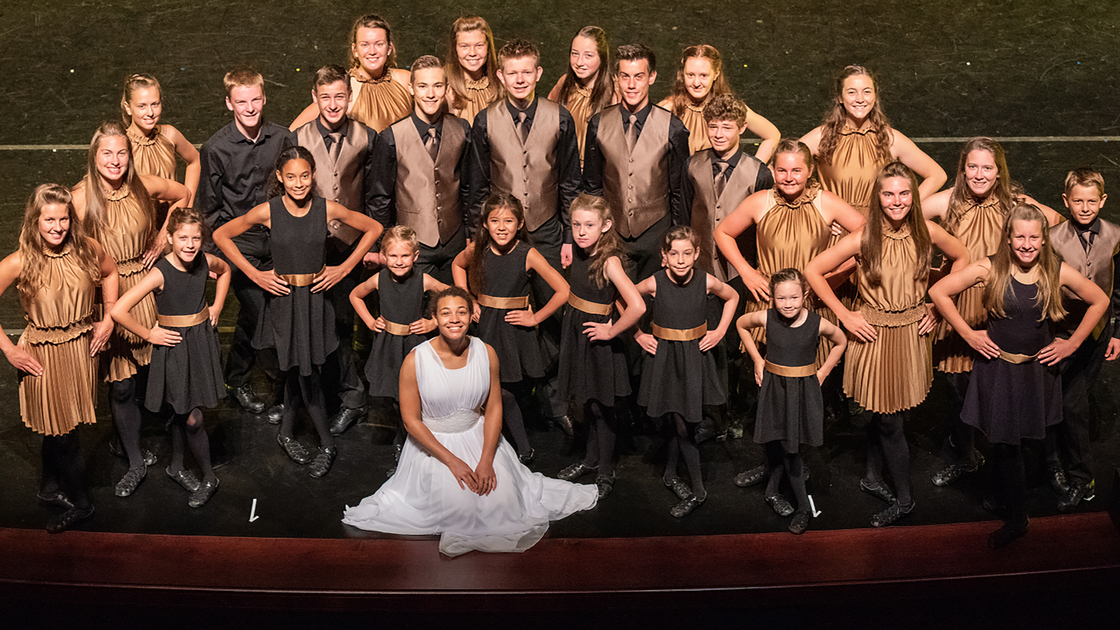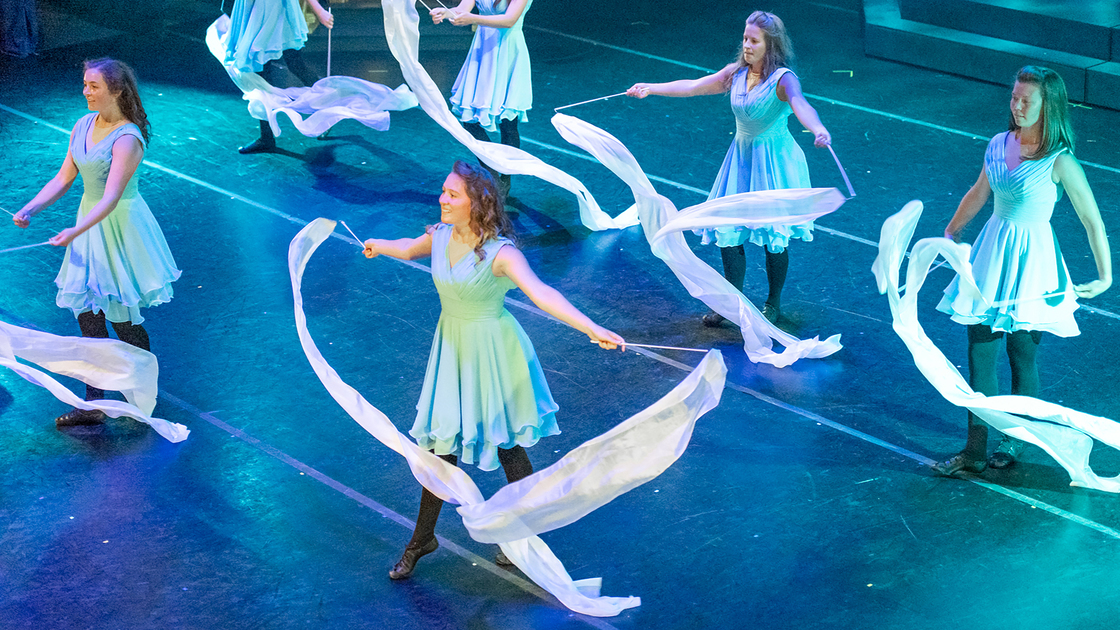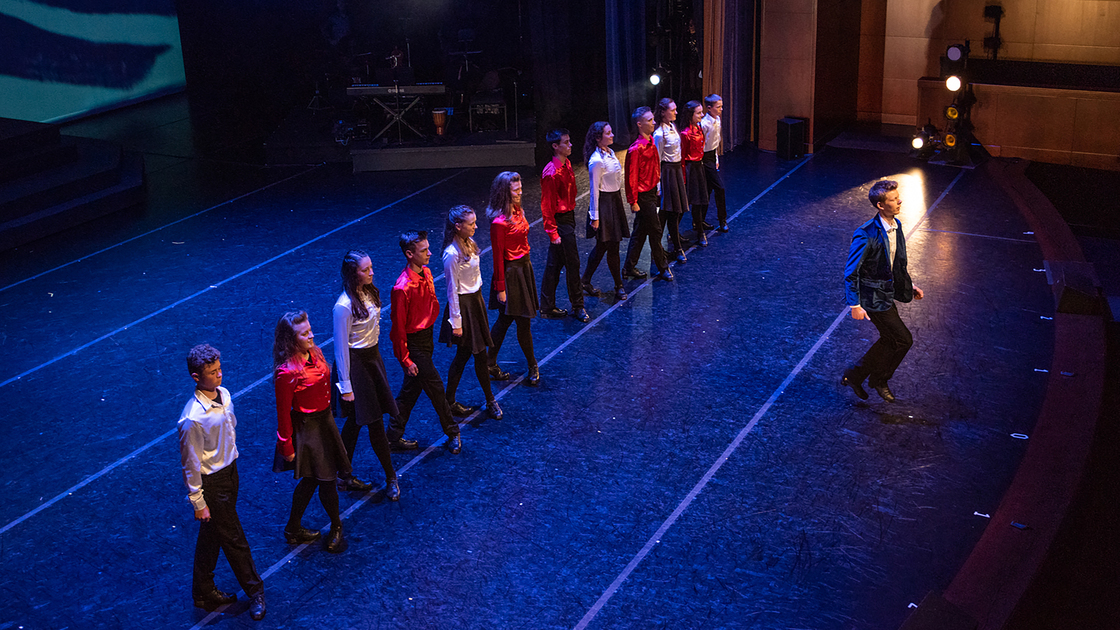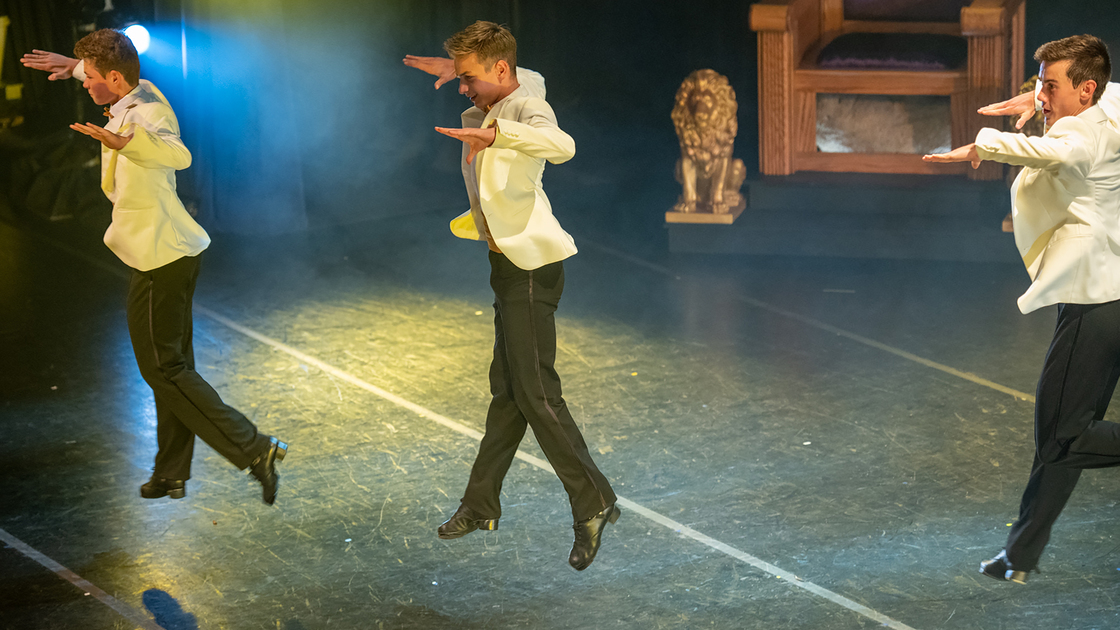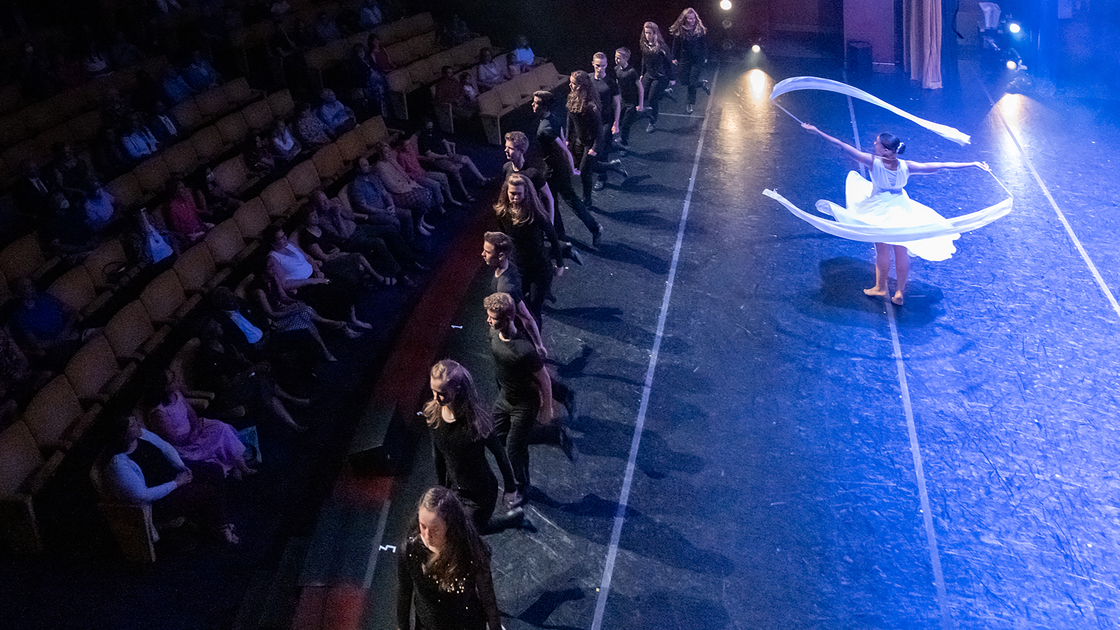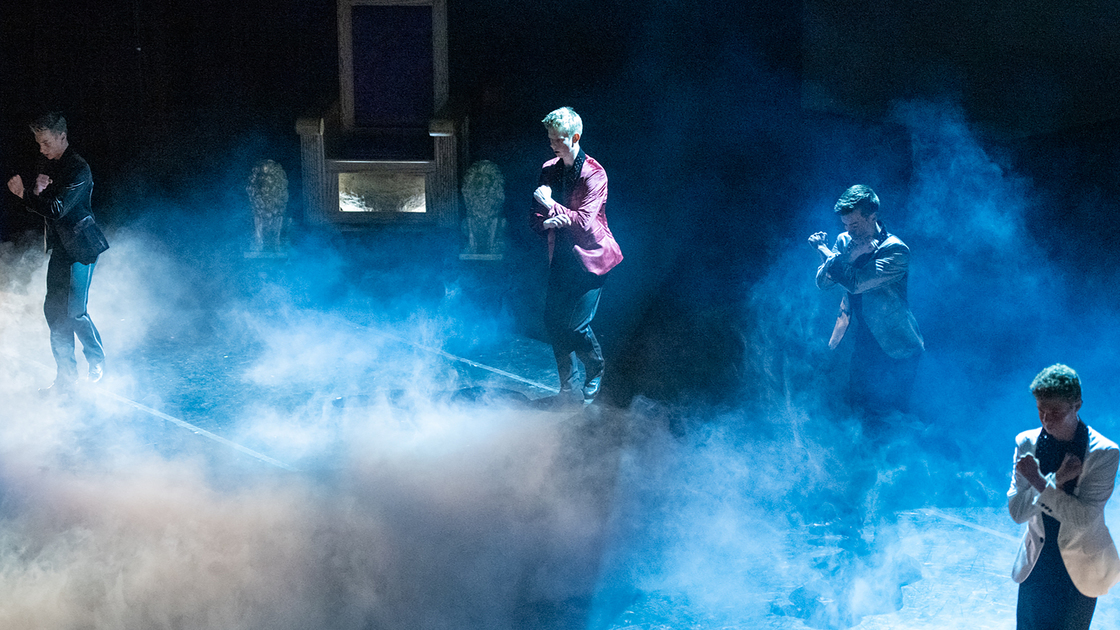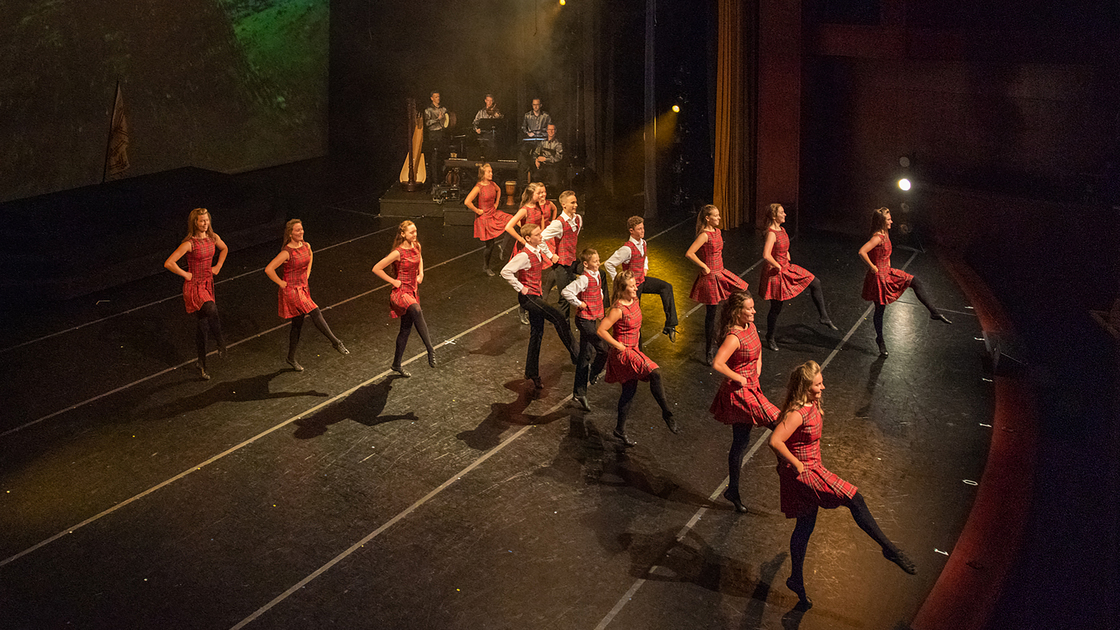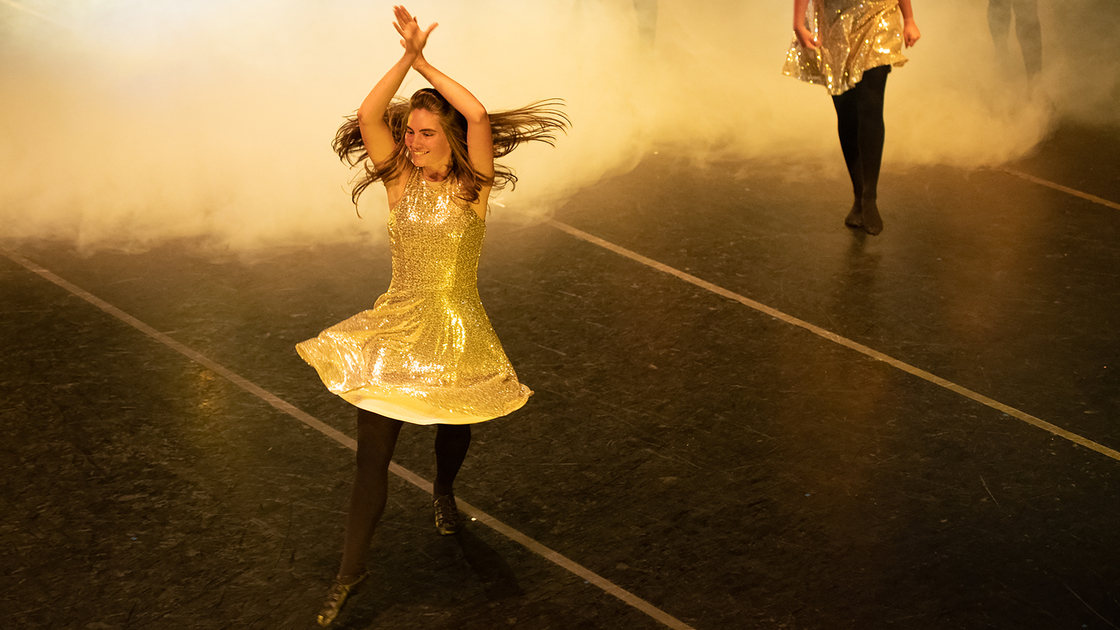EDMOND—The lights dimmed and the curtains parted to a starry background and a lone silhouetted figure. The figure turned, descended the risers as the music swelled, then burst into the light and onto the stage as Celtic Throne stamped, rang, whirled and flashed to life on Sunday afternoon at Armstrong Auditorium. The 54-foot stage soon filled wall-to-wall with 36 dancers stepping in unison and introducing the crowd to the ancient biblical origin of Irish dance as envisioned by Armstrong Dance and as composed by musician Brian Byrne. And this was only the first number.
With a cohesive combination of choreography, costumes, graphics and lighting conveying the music by the Golden Globe-nominated composer, the Irish dance show told the national history of the dance form, beginning with King David and following his royal descendants and their peoples from ancient Israel to ancient Ireland and on to Scotland, England, the United States and beyond. With unabashed yet fresh patriotic strokes and tones, the dancers celebrated the best of each of these peoples and the lands they inhabit, seven steps at a time.
The crowd of 359 in the theater and those watching more than 300 devices in about a dozen countries streaming the show live online followed the steps, hops, crosses, points, tips, leaps, twirls, kicks, hornpipe, jigs and reels of dancers in black and clover-green through the lush hills and gray crags of Ireland; in red-gold Scottish tartans amongst the grassy highlands and misty isles; in scarlet tunics evoking the Queen’s foot guard before Buckingham Palace in England; in more muted folk dresses, aprons and vests on the American frontier; and in shining, sequined gold dresses and white jackets before a background depicting a future beyond Earth itself.
Costumes, procured and sewn over a course of months by several volunteers, also included light blue dresses for dancers with flowing white streamers representing a sea voyage, and blacked-out sequined dresses used in dramatic, fearsome dancing depicting the downfall of nations, the sense of turbulence enhanced by fog effects cut through by flashing strobes, serious expressions and the rapidity and thunder of the hard-shoe taps themselves. Two of the numbers began with dancers beside and behind concertgoers, dancing and marching through the aisles to the stage. For a couple of the performances, concertgoers clapped along. Between the last note of a number and the dancers’ exit of the stage their movements were also intentional and largely choreographed, part of the show. Far more noticeable, when they returned for the next piece, were the dozens of bright eyes and brighter smiles.
The 90-minute production, which included a 20-minute intermission, also included five songs. Following the American medley, an elderly lady in the front row of the balcony led the entire balcony audience in a standing ovation. The last song before the finale dance number featured a quintet of singers who were gradually joined by the dance troupe performing as a choir.
The final number filled the stage and the senses as much as and more than the first, building out a grand finale that brought the entire theater, balcony and orchestra-level to its feet, then transitioned into a choreographed encore and curtain call, that transitioned into the dozens of dancers retreating as the music played on, smiling and waving goodbye, the curtain closing, and a final punctuation of a loud chorus of cheers from behind the curtain.
Concertgoers applauded, clapped along and cheered loudly. At intermission and after the finale, an atmosphere buzzing with positivity and excitement filled the theater, the halls and the lobby, where hundreds gathered to converse and were soon joined by the performers, still in costume, who chatted with visitors and took photos with family and with each other, a few hours of relief and celebration before taking the show on the road the following morning.
Comments by concertgoers included “We’ve never seen anything like this, it has been amazing;” “It was magnificent,” and “It was much more spectacular and grander than I expected.” “To say that I enjoyed it is too much of an understatement,” one woman said.
Some Celtic Throne concertgoers posted about their experiences online, writing on TripAdvisor: “Blown away by the power;” “Great performers with lots of variety in dance, songs, ages, and music” and “So nice to see young people work so diligently to present an event we’ll never forget.”
Assistant Director Paris Turgeon said “The premiere performance went better than expected—especially from a staging and technical point of view.” She said that the “biggest challenge” was the limited time available to practice the stage changes and lighting. But she said the stage transitions and technical details were “seamless” during the premiere performance.
The concept for the show originated with Philadelphia Church of God Pastor General Gerald Flurry and his son, Evangelist Stephen Flurry, with discussions beginning in earnest in December 2018. A dance building on the Church’s headquarters campus had been completed two years prior. The Church’s dance department queried several composers about commissioning music for the show and was surprised that Heartbeat of Home composer Brian Byrne responded, was interested, had availability, could be afforded, and coincidentally had a home about 40 minutes from campus. Initial production of the show began after Brian Byrne’s visit to campus in August.
Mr. Flurry said he considered this an open door from God and announced the production at one of his 2019 Feast of Tabernacles sermons, yielding some his time to show a video of young people in the Church who attend Herbert W. Armstrong College and Imperial Academy performing Irish dance. United Kingdom-Europe Regional Director Brad Macdonald began discussing the performance in more depth at that point, and Mr. Flurry put him in charge of the dance department and the show.
In addition to its weekly classes, the department held a week-long dance camp that ended January 3, when the pastor general gave a special address to the dancers, telling them it was important for them to work hard and use the opportunity to praise God. The following months involved more than 50 pcg children and adults. Dozens of parents, Church staff members and other workers spent several hours a week, and more during school breaks, developing choreography, teaching, practicing, sewing costumes, building props, designing backdrops and programming lighting.
Most of the manpower expended was by the dancers, who are noticeably young, ranging in age from 4 to 22, and practiced for hundreds of hours. Another unique feature and challenge of the preparations was that it included choreographing dances to include 11 pcg youths who do not live in Oklahoma but take Irish dance and were accepted to be part of the show. They practiced their steps alone, while the group practiced their steps together leaving spaces where their friends would eventually be.
The choreography was developed and taught by several young people who are recent, current or incoming students at Herbert W. Armstrong College: Alexa Turgeon, Vienna and Jude Flurry, who taught students from preschool to college-age in person and online. The choreography departs from strict classical Irish dance to include arm movements and endeavors to clearly differentiate one number from another and to blend with Byrne’s music.
“I don’t think you cannot be moved when you are listening to his pieces in some form,” Paris Turgeon said, “because they really are big, and they can be very powerful and emotional.” Others described the music as having a cinematic quality.
Mr. Macdonald said that the production has experienced several miracles, including Byrne agreeing to compose original music for almost the entire score at a greatly reduced fee and the ability to purchase necessary lighting equipment and receive it in time despite delays and hurdles caused by coronavirus restrictions. He said this proved that the show is important to God. In a Bible study at headquarters on June 27, he asked church members to pray about all aspects of the effort for the next few days: audio-video needs, choreography, costumes, lighting, music, performers, props and score, and especially the health of everyone involved, “This is a pretty big undertaking, and we all want it to be the highest standard we can possibly achieve,” he said. Mr. Macdonald emphasized the deep spiritual meaning that each number and song in the show has for Church members, and said that non-PCG audience members will enjoy it as a patriotic, positive presentation of the history of the dance form King David originated and of the perpetuation of his throne.
The premiere is over, but Celtic Throne is still tracing the throne of David from its inception in ancient Israel through Ireland, Scotland, England and America for new audiences. Before many concertgoers and performers left the auditorium after the premiere, maintenance crew members were loading equipment into trailers, staff were preparing to hit the road and final preparations were made for two performances at Dutton Theater in Branson, Missouri. The next crowd to experience Celtic Throne sees it tonight at 8 p.m.
Paris Turgeon said “You can tell the kids are tired,” but she added that “We encouraged them to continue using this week to progress, so that our final shows back in Edmond are even better than the premiere.”
Another crowd will see the performance at 10 a.m. tomorrow at Dutton Theater, and the show returns to Armstrong Auditorium on Sunday (July 5), with virtual tickets for the online live stream ($8) available here. The show’s final scheduled performance is Tuesday (July 7). Tickets to attend the latter two shows in person are available here.
